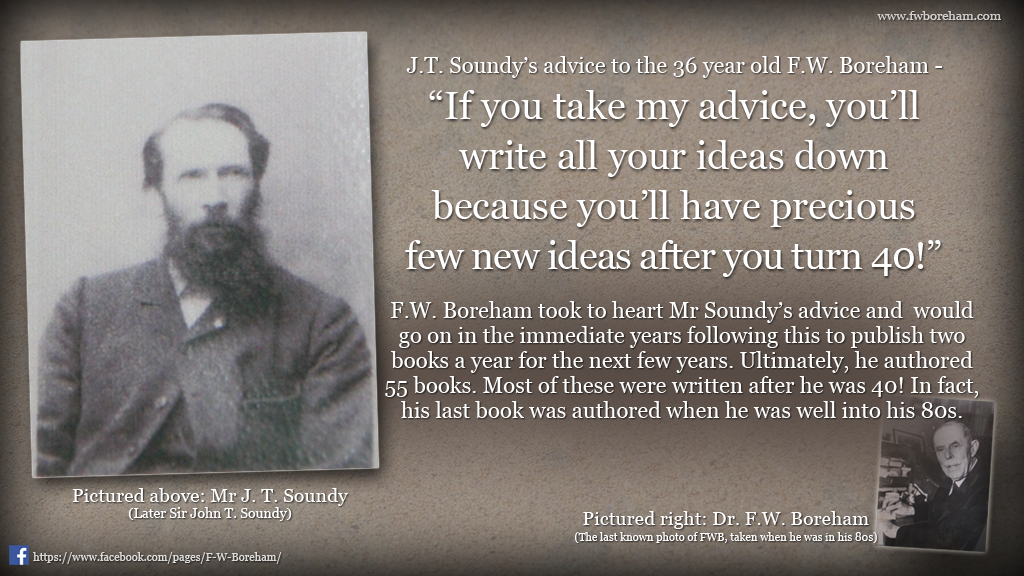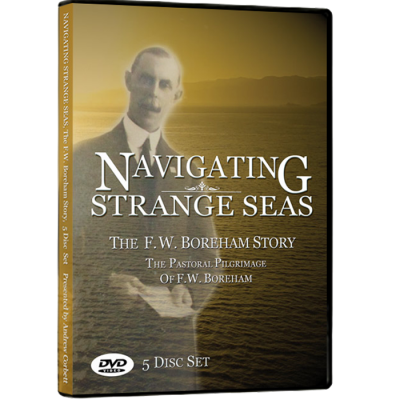home > insights > How FWB Avoided Writer’s Block
 Did F.W. Boreham ever experience ‘writer’s block’? At the height of his output, he was writing regularly for several newspapers and magazines, publishing up to two new books a year, preaching twice a week, and also contributing to denominational journals and national periodicals. Boreham was clearly concerned by the possibility of writer’s block because he was haunted by the eminent J.T. Soundy’s sombre warning that he should write all he could before he turned 40, for “You’ll have precious few new ideas after you turn 40!”
Did F.W. Boreham ever experience ‘writer’s block’? At the height of his output, he was writing regularly for several newspapers and magazines, publishing up to two new books a year, preaching twice a week, and also contributing to denominational journals and national periodicals. Boreham was clearly concerned by the possibility of writer’s block because he was haunted by the eminent J.T. Soundy’s sombre warning that he should write all he could before he turned 40, for “You’ll have precious few new ideas after you turn 40!”
As it turned out, J.T. Soundy was wrong. In fact, FWB’s best work came after he was forty. Perhaps it was because of Mr. Soundy’s warning, but F.W. Boreham took several pre-emptive steps to ensure he never succumbed to the dreaded writer’s block. In particular, he did three key things that ensured that even after he died, the Melbourne Age newspaper was able to publish his weekly literary feature articles for nine months! And a few years after his death, it was discovered by Dr. Geoff Pound in the FWB archives at Whitley College (Melbourne) that FWB had commenced a book project in his latter years which he had not finished. (Dr. Pound completed this book from FWB’s editorials and it is available online.)

THE THREE THINGS FWB DID TO AVOID WRITER’S BLOCK
Dr. Boreham did three significant things to maintain his writing creativity. Firstly, he had a daily discipline of writing each morning at the same time. He developed this as a routine. Secondly, when a new idea came to him he wrote it down with a view to fleshing it out later. The third thing he did was to feed his soul with the arts – which included his ongoing commitment to reading good books, regular visits to the theatre, and weekly visits to the State Art Gallery.
Each of these three things required Boreham to ponder. This contemplation enabled FWB to engage with his subject in very creative ways. His fascination with St. George Hare’s painting, The Victory of Faith, is a great example of this.
There is no painting in our Melbourne Art Gallery of which I am more fond than of Mr. St. George Hare’s ‘Victory of Faith. It presents two young girls-one of white skin and one of black — awaiting martyrdom in an ante-room of the arena. On the morrow they are to be thrown to the lions. And how are they spending their last night on earth? With their arms lightly thrown about each other’s shoulders, they are fast asleep. And Mr. St. George Hare calls it The Victory of Faith. Victory-over what? Victory over all the might of the Caesars: what do they care for the tyranny of their persecutors? They are sweetly sleeping! Victory over all their feminine frailties: the lions have lost their terror; they are in the land of lovely dreams! Victory over all racial prejudice: black and white are in each other’s arms! Victory over death, for, to them, death has no more terror than the slumber in which they are now indulging.
A Late Lark Singing, A Splinter of Stone
As discussed in the YouTube video we recently published about Boreham’s treatment of this painting, Boreham was prepared to tackle a controversial piece of art and masterfully ‘redeem’ it. The same could be said of how FWB changed his view about going to theatre (which is also discussed in a recent YouTube video which you can view below).
Drawing on FWB’s strategy for avoiding writer’s, or preacher’s, block, I have found his books to be goldmine of inspiration for finding sermon and literary illustrations that have beautifully reinforced the central point of a Biblical text. If you’re a writer, how have you managed to avoid “writer’s block” and have you also found Dr. Boreham’s essays inspirational for your ministry? Share your comments below.
Andrew Corbett


















0 Comments